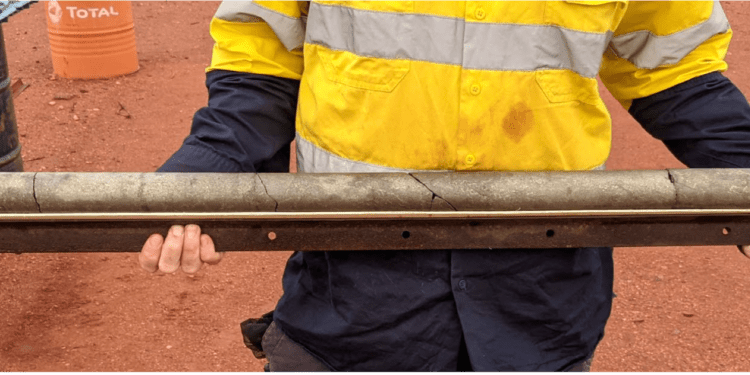Assay Results Define Important Breakthrough In Cathedrals Belt Exploration
St George Mining Limited (ASX: SGQ) has confirmed the latest high-grade nickel- copper sulphide discovery at its flagship high-grade Mt Alexander Project in the north-eastern Goldfields of Western Australia.
Executive Chairman, John Prineas, said laboratory assays show that the from discovery made by hole MAD199 is below the shallow deposits already discovered at Investigators and is the latest high-grade nickel sulphide find across the Cathedrals Belt at Mt Alexander, where the company continues to grow the footprint of this critical battery mineral.
Results from hole MAD199 are: 11.07m @ 1.58% Ni, 0.71% Cu, 1.23g/t total PGEs from 333.5m including 3.9m @ 3.98% Ni, 1.8% Cu, 3.1g/t total PGEs from 340.67m and including 1.28m @ 6.54% Ni, 2.96% Cu, 3.88g/t total PGEs from 342.12m
Notably, as the deepest massive nickel-copper sulphides identified in the Cathedrals Belt, MAD199 has confirmed that the large intrusive mineral system at the Cathedrals Belt can host significant high-grade mineralisation at depth.
“The high-grade intersection in MAD199 is a very important breakthrough in our exploration of the Cathedrals Belt,” Mr Prineas said.
“The MAD199 discovery is the deepest occurrence of massive nickel-copper sulphides identified in the Cathedrals Belt and supports the prospectivity of more high-grade deposits at depth.
“With multiple strong EM conductors identified from MAD199 as well as from the first step-out hole at MAD201, we are confident of drilling more high-grade mineralisation in this area.
“The search for nickel-copper sulphides at depth is still at an early stage and we are pleased to be rolling out a low-cost seismic survey that has the potential to identify in high-resolution the intrusive host system and any mineral deposits at depth.
“These results and our ongoing work are very positive for the growth potential of the high-grade mineralisation at Mt Alexander.”
The first step-out hole for MAD199 was MAD201, which intersected a 16m thick intrusive unit from 421.95m downhole including a 2.4m interval of nickel-copper sulphides from 434.6m.
The downhole EM survey in MAD201 identified three very strong conductors located up-dip towards the high-grade intersection in MAD199. The conductors are modelled with conductivity of 120,400 Siemens, 30,000 Siemens and 23,000 Siemens, respectively. This supports the potential for the presence of more massive sulphides along the 125m down-plunge extent between these two drill holes.
Mr Prineas said he geology and mineralisation display a largely preserved section of a mineralised intrusive unit. Classic intrusive features are observed including the presence of leuconorite and gabbronorite which are known to host major intrusive nickel sulphide deposits in Western Australia.
The nickel-copper sulphide mineralisation increases in volume towards the basal contact, with massive sulphides on the contact, and represents a textbook profile for preserved nickel sulphide deposits.
Deep Ground Penetrating Radar (DGPR) survey:
Meanwhile, acquisition of the field data for the DGPR survey has been completed with survey data now being processed and modelled. A total of 37.5 line kilometres of data was captured in the survey.
The DGPR survey measures a combination of rock dielectric and conductivity to map below-ground lithology and metal deposits in high-resolution. Case studies have shown that the DGPR can successfully map base metal mineralisation in the top 100m to 150m from surface, particularly in granite terrain like the Cathedrals Belt.
The DGPR data is expected to allow St George to model the high-grade massive sulphides in 3D which would greatly assist in resource definition drilling and targeting extensions to known mineralisation.
Seismic survey
A new, cutting-edge seismic technique, called eVibe and offered exclusively by Ultramag Geophysics, will be trialled at the Cathedrals Belt. Conventional seismic techniques are considered not feasible for use at the Cathedrals Belt because of their relatively higher cost and lower resolution.
The latest eVibe seismic applies a fraction of the force compared to a conventional seismic hydraulic system but delivers high quality data to a similar depth. The cost of eVibe is significantly lower than conventional seismic.
The seismic survey at the Cathedrals Belt is scheduled to be completed in mid-July 2021
For further information please visit: https://stgm.com.au












